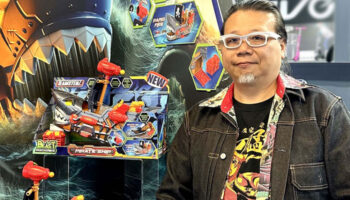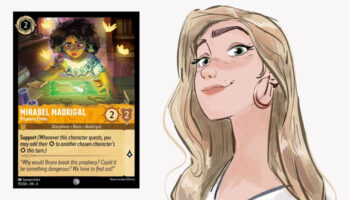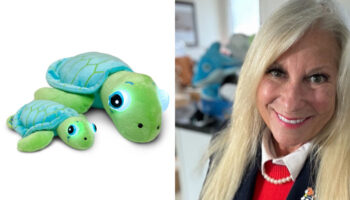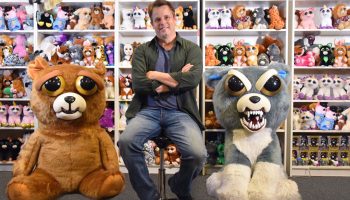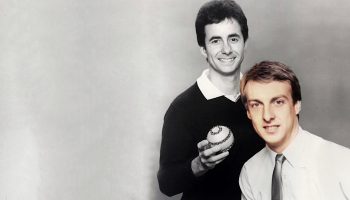Pace Development’s Robert Schwartzman and Peter Williams on how constraints fuel creativity

“Inventing is playing”: Robert and Peter from Pace talk us through recent launches, including the Hot Wheels Transforming Rhinomite RC and Mattel’s Transforming Ariel Doll…
Guys, I’m delighted to be chatting with you both. To kick us off, what do you think set you on the path into toy invention?
Peter Williams: Growing up, all of my favourite play experiences came from toys we made, or in particular, my father made us. There was never a moment in my life where the most fun thing came from a store.
One particular memory that dates me is that Star Trek was on TV – the original series. My dad cut out the silhouette of a phaser gun out of plywood and painted it black. He actually made two, one for me and one for my brother… We owned the neighbourhood! It was the coolest thing! It was no more sophisticated than kids playing with sticks, but it was so powerful to see something go from my dad’s imagination and into the real world. That opened my eyes to this sort of thing.
Amazing. And was your dad a designer?
Peter: Yeah, he was an industrial designer. He didn’t start working on toys until I was around 10 years old, but as a dad he was always making stuff. And he makes for a nice segue into Robert’s story actually!
Oh?
Robert Schwartzman: Yes, he looms large in our story. In terms of my path, my brother and I were always making up games. They were a big deal for me growing up and still are – we’re actually starting to dabble more in games now… But when I graduated school, I went to work for an inventing firm that made baby products. And Pete’s dad was the partner and design director there. That was my apprenticeship; I learned everything from him, from the major stuff to the minor stuff.
I was at that company for three or four years and had gotten bored with the baby stuff, so I left – and Peter’s dad joined me a year later. Then he retired and introduced me to Peter and there were fireworks immediately. So Peter’s dad was integral to our story; he set the pace for both of us.
Speaking of setting the pace, is that where the name Pace Development came from?
Robert: The company I worked for was called The Child Growth & Development Corporation… Quite a mouthful! I also have a very long last name, so I just wanted a four or five letter word that was one syllable! I just wanted something short so someone could say “That’s Robert from Pace”.
I live in Soho and my favourite art gallery is called the Pace Gallery – it’s now in Midtown. I walked by that gallery one day, struggling with lots of bad name ideas, and Pace resonated! It was one syllable, it’s positive, I pace around a lot…It was the one!
It was the one! Now, why do you think you guys work well together? What’s the secret sauce?
Peter: Some of the spark between us initially was dissipated energy because we couldn’t understand the other person’s view, because we look at things so differently. Then we realised that’s where the value lies, in the difference. Over time, we’ve internalised the other person’s world view, so it’s a more refined collaboration.
Robert: Yes, these days I sometimes feel more like him, and he feels more like me! But I’ve been a very lucky guy to have a partner like Peter. It was a life-changing opportunity. Every day is interesting, fun, informative… It’s sometimes complicated but we always get to something positive, both in terms of product and our relationship. To me, he’s right 51% of the time and I’m right 49% of the time. I used to feel the opposite, but it’s liberating to want to know what your partner thinks – even if you don’t agree with them. That’s where we’ve got to after all these years.
Peter: We’ve got very good at listening, both to each other and to our clients.
Peter, you’re based in Hawaii and Robert is in New York. So how does the collaboration between you work in practice?
Robert: We both come up with ideas and we pitch each other ideas all the time. Pete knows so much more about how things can be done, how to make it better, how to cost-reduce it… I take on more of the communication with clients and the pitching, but I wouldn’t make any decisions around pitching without speaking to Pete first.
Peter: I really appreciate Robert’s ability to strategically identify opportunities. A lot of people think about invention and creative work as being grounded in freedom, but it’s constraints that breed opportunities. And often, the bigger the constraint, the bigger the opportunity.
Was there an early toy or game you licensed that helped establish Pace in the invention space?
Robert: We had one or two hits before this, but we did a doll called Dancin’ Debbi for Mattel in 2000. It was a TV driver for Mattel and sold over a million pieces. It came back a few years later as a Barbie item. All of a sudden we had a top 10 hit in the industry, and everyone knew we did it… The exposure was great and it helped us a lot financially. Mattel did an outstanding job of promoting it and promoting us. It was a real turning point for us.
We had never done an electromechanical doll and I wasn’t sure we could do it. It felt a little above our skillset… But Peter said: “We can definitely do it!” He not only made that thing happen conceptually but convinced me that we could do something that big.
Amazing. And how did the idea for Dancin’ Debbi come about?
Robert: I remember being in the Noho Star and Pete brought me a very rudimentary breadboard. You explained to me what a contrapposto was; you knew about that from your art training.
Sorry to cut in, but what is contrapposto?
Robert: It means counterpose, and centres of alternating hips and shoulders… So when this side of the hip goes up, the alternative shoulder goes down. Peter then showed me a breadboard of a doll moving in that way. He felt it made for a dancing doll that was truer to life. I was blown away by that!
And here’s the ad, so people can appreciate how that looks on a doll.
Was it an immediate slam-dunk when you pitched it?
Robert: The magic of that toy was that it had a really unique input. We pitched it, Mattel liked it but the project hit a tremendous skid… We had a meeting and they told us: “It’s not happening because this input you designed is not working for us.” Peter – on the spot in that meeting – said: “Well, what if the girl wore a bracelet that sent a signal to the doll?” He came up with another giant invention on top of our dancing doll! It was a eureka moment! They loved it and that was the answer to the problem.
Wow! Terrific story. And great on-the-spot thinking Peter!
Peter: That’s the holy spirt! That’s the best part about what we do… We don’t know when those sparks are going to arrive or land. That’s the mystery of it… We just have to show up, keep the lights on and wait for those moments.
And I suppose emotionally, you didn’t react with despair to that news; you didn’t shut down creatively out of disappointment. You immediately embraced the opportunity that it presented. I imagine that’s key to being successful as an inventor.
Peter: That’s a powerful insight. That must resonate with anyone that’s interested in this process because if you don’t have that approach, good luck to you. There’s so much rejection, but within the rejection there’s information. Pain is information and intelligence is error correction… Anything that comes our way – positive or negative – we have to turn into forward momentum. Good news, bad news, the answer is always: ‘Make more toys’. The other thing is that we’re ‘playing professionally.’ Fear and play don’t mix. Anger and play don’t mix.
Great insights. Thank you. Post-Dancin’ Debbi, was there ever an appetite for Pace to be known for inventing a certain category of toy?
Robert: It’s funny, we don’t have a specialty, but every client thinks we do! We started off in pre-school because we knew that area really well. Then we did that doll, and everyone thought we invented girls’ toys. All of a sudden people wanted to know what we thought of their doll lines! In the past few years, we’ve got into RC in a big way and we’ve sold a lot of stuff – both RC and non-RC – into Hot Wheels and other companies… And now we’re about to start doing more in games, so people might assume we’re game inventors!
Peter: People called us the ‘Barbie guys’ for years!
Robert: Not a bad name to be associated with! We love the Barbie brand, but we do other stuff too. Wherever our success has led us, that’s what people assume we do! Two years ago, we went hard into baby items like strollers – they’re not toys. We thought, if this stuff comes out, people will say: “You guys did this!?” Fundamentally, we love finding solutions to problems our clients are having. There’s almost nothing we won’t work on.
You’ve worked with lots of different inventor relations execs over the years. What makes someone good at that job?
Peter: An inventor relations person that is respected by the brands they represent; that’s key. You can immediately tell when someone is a true ambassador to the brands that they’ll be showing things to, and the best ones are incredibly loyal to their brands. They have the trust of the brand teams and understand the value of what they’re reviewing.
Robert: Ambassador is the right word. There’s a subtle difference. There’s checking in on the status of an item internally and finding out that it’s in costing, for example. That’s the minimum… And then there’s an IR exec finding out it’s in costing and saying: “Well, you know, the inventors can help with that. They can get you a BOM if you want?” Or the ones that might tell their teams: “You know, we’ve held this a long time, we owe these guys an option.”
If they have the respect of their brand teams, those teams will trust what the inventor relations exec wants to do. It’s a subtle difference in approach, but it makes the world of difference.
On that, what makes a good internal brand person?
Robert: It’s the people who look for the ‘yes’. They still have all the usual struggles you have to deal with internally, but the top ones always look for the ‘yes’. It might be the difference between hearing “we can’t do that” and “we can’t do motorised toys, but that’s a cool mechanism – can you try that as a…”
Peter: And a good inventor relations ambassador is not threatened by the relationship between inventors and the brand leads. Our relationships with certain brand leads means we’re sometimes inventing with an individual at a company in mind. That can be really useful.
Robert: And we follow people as they progress through different companies and different brands. We go with them.

Fantastic. Right, let’s talk about some of your recent launches. The Hot Wheels Monster Trucks HW Transforming Rhinomite RC looks fantastic. How did that come about?
Peter: It actually ties into what Robert was just saying. When we saw there was an opportunity to work with Ted Wu and Gerry Cody, we were in. They told us about a challenge they had – that RC is plastic by the pound… It’s a tough category to compete in.
We looked at what could differentiate a Hot Wheels RC from anything else out there. What can Hot Wheels do that no one else can? That led us to the orange track and questions of how we could boost a die-cast with RC… The equation was: Orange Track + RC + Die-Cast = ? Then we scratched our head for a year until we got to the product!

Robert: The Hot Wheels team was incredibly supportive. It was a dream project to work with them on. The final concept felt truly Hot Wheels and that’s what’s made it a success.
Absolutely. And you guys also did Mattel’s The Little Mermaid Transforming Ariel Doll?
Robert: Yes! The story is obviously of a mermaid who wants to be a human, and we captured that in one transformative moment. You push the shell on her necklace to transform her skirt into a mermaid tail and fin. Mattel did a beautiful job; the doll itself is spectacular. And with both the Rhinomite and this, if you look at our original submissions, they’re almost identical to how they came out.

Lovely! Are there any other launches we should shine a spotlight on?
Robert: One I’d love to talk about is the Hot Wheels Roll Out Raceway. It’s not a recent launch, but it’s still doing really well and is a great example of the power of listening to clients.
The client shared an insight with us – parents can’t stand having cars laying around the place. They step on them, they kick them under the sofa… They needed a fun toy that also had storage in it. Peter made more than five models of this and we brought it back again and again over years…
Peter: Yes, it’s a nice counterpoint to the smoothness of those previous two items! When we enter a new category, we miss a lot! We learn a lot and we listen a lot – and that’s key… One term the Wheels team used was ‘a bucket of cars’… They’d say “every Hot Wheels fan owns at least 20 cars and there’s always a bucket of cars”. I said to Robert: “Is there an actual bucket?!” That’s how this actually started! We heard that term and said, well, let’s make the actual bucket!

Ha! That’s brilliant. And how many cars does this real bucket hold?
Robert: It holds around 50 and it comes with one car. It then unfolds into a track set with a finish line, so you can race your cars. We’re so proud of this one. It’s now in its third year and selling well. That was the other insight actually… They wanted an evergreen item. It wasn’t going to be a TV driver – and shouldn’t need to be. They wanted something that could sell year in, year out and you know what it does just by looking at it on shelf.
Do you find insights usually kick-start your creative process?
Robert: It can be a mix of things, but yes, those insights, challenges and constraints from clients can be a major source of creative fuel for us.
Peter: Restrictions really fuel creativity.
Robert: The other thing is that Pete will sometimes show me a mechanism, or we’ll look at something we’ve developed and say: “Oh, that’s not a doll… That’s a game!” Sometimes the mechanism drives the whole story, and other times the mechanism will stay but the story will change.

We mentioned earlier that Peter, you’re in Hawaii, and Robert, you’re in New York… Do these places feed your creativity in any way?
Peter: It probably does. The amount of sunlight and natural beauty helps. Inventing is playing, and to play you need joy. So it doesn’t hurt if it’s warm and beautiful… It makes it safe to play I suppose.
Robert: If I was where Peter is, I’d want to be in a hammock all the time! I wouldn’t be a very good partner! Being in New York, I’m creatively stimulated by everything around me. Fashion, people, vehicles, advertising… I saw a vehicle two days ago that I’ve never seen before and that was inspiring. Being here keeps me creatively limber.
Before we start to wrap up, what do you think is the key to sustaining long-term success as an invention studio?
Robert: For me, it comes down to having a great partner. I tell people: ‘Don’t do this alone’. We’ve had good years and bad years, but we’ve always had each other. It makes the victories sweeter and the bad times better. Bouncing ideas between us really shapes what we produce, and you can’t do that alone.
Peter: A long time ago, my dad told us: “When you’re doing something for yourself, it’s good to do it by yourself. When you’re doing something for other people, it’s good to do it with other people.” We’re making toys for other people, so having a great partner or team is key.
Fantastic line. Guys, this has been great. I have one final question: What’s your most underrated item?
Robert: Easy! It’s the Bug Racer. It’s an item we placed with Mattel that’s a vehicle driven by an actual bug.
Ha! How does that work?
Robert: You go outside and use the collection device to collect a bug. It’s actually a little habitat for the bug to keep the bug alive… There’s air holes and a feeding drawer. But you then put the habitat into the vehicle, turn it on and there’s a motion sensor in there. The bug moving triggers the motor to move and that moves the vehicle. If the bug doesn’t move, the vehicle doesn’t move! And Mattel did a great job. We just showed them a vehicle with a sensor on it, with a bug sitting in a dome, and they ran with it.

There’s a funny story with this too. We weren’t going to show this to Mattel. We created it with another company in mind. Then Doug Wadleigh – who was then a Senior VP at Mattel – stood up at an inventor gathering and said: “Show us the weirdest thing you have! We have to disrupt!” So we showed them this and they took it on the spot!
I love this. How did it do?
Robert: It didn’t do great. It was sold in the science aisle, so people didn’t really find it… It was being sold next to rock tumblers! But the reviews were great.
Peter: A brilliant, unexpected consequence of this toy was that, because you needed to have a live bug for it to work – and kids can’t get that by themselves – they would have these wild adventures with their parents to find bugs. That was heart-warming to hear.

Can I ask – and I mean this nicely – how do you gauge if an idea is too mad, or just mad enough? Because Bug Racer is quite mad… Brilliant, but mad!
Robert: Ha! It’s a great question – and people do think we must’ve been stoned when we came up with it, but we weren’t! It came from a serious brainstorm around cool ways to get a vehicle to move.
Peter: We look at the barrier to entry… So the root invention here is very simple – it’s a motion sensor hooked up to a toy car. If you can get to that proof of concept easily, the idea around it has a chance – no matter how mad the idea might be. Then there’s the reputational part of things…
Robert: Yes, generally we don’t take swings like this. We usually try to solve problems our clients might have. Every once in a while, to prove to ourselves and to our clients that we can bust outside of that box, we do try things like this. We don’t want to make that sort of thing our main fare – because we have to sell our toys! – but occasionally, if something’s unusual, we’re having fun with it and it’s not expensive, we’ll embrace that.
Amazing. Thanks again guys. Let’s do this again soon.
–
To stay in the loop with the latest news, interviews and features from the world of toy and game design, sign up to our weekly newsletter here





